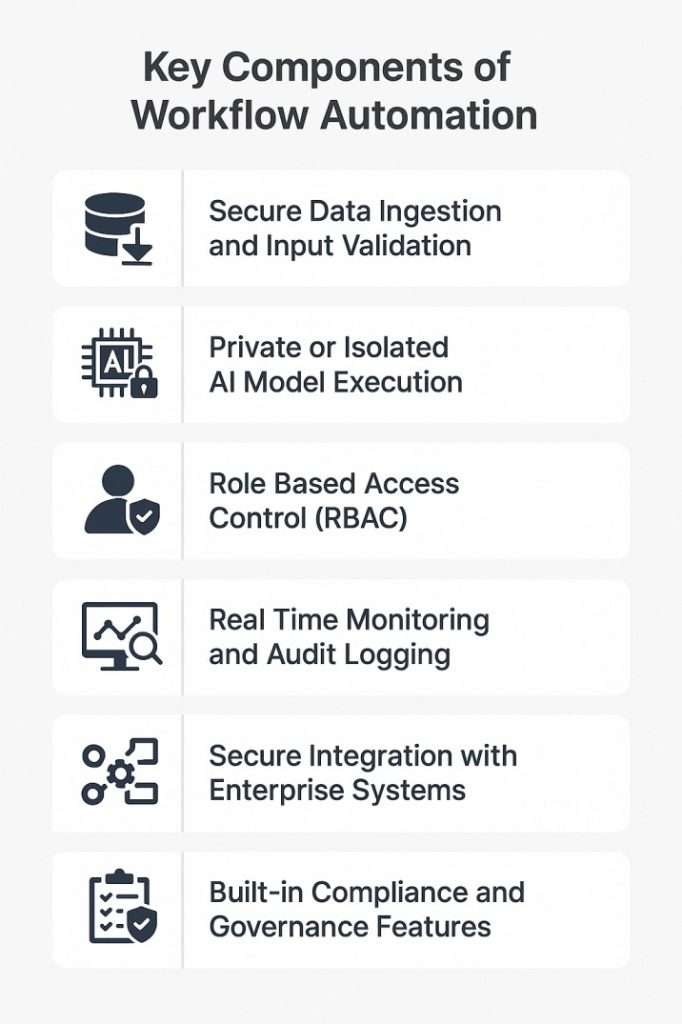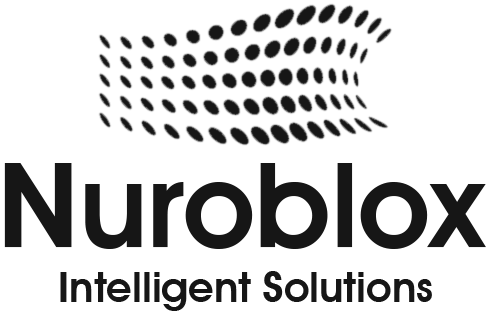Secure AI Workflows: How to Automate Without Compromising Data
AI-powered automation is transforming how businesses operate, accelerating processes, reducing costs, and unlocking new efficiencies across industries. But as organizations increasingly rely on AI to handle sensitive tasks and data, a critical challenge has emerged- how to automate securely.
Many traditional AI workflows were not designed with security or privacy in mind. They often rely on public cloud models, third party APIs, or opaque data handling practices that expose businesses to data breaches, regulatory violations, and reputational risk.
This is where secure AI workflows come in.
A secure AI workflow ensures that automation is built on a foundation of data protection, transparency, and control. From encryption and access management to compliance ready architectures, secure workflows allow organizations to harness the power of AI without compromising sensitive information.
This blog explains the risks of using AI without proper security, what makes an AI workflow safe, and how businesses can build secure, privacy focused AI systems that grow with their needs.
What Makes an AI Workflow Secure?
A secure AI workflow is more than just a well functioning automation process; it’s a system built from the ground up to protect data, enforce compliance, and maintain control throughout every stage of the workflow. From input to output, each layer is designed to reduce risk and ensure accountability.
Here are the key elements that define a truly secure AI workflow:
1. End to End Data Encryption- Data must be encrypted at rest, in transit, and during processing. This ensures that even if intercepted, the data remains unreadable to unauthorized users. Secure AI platforms use enterprise grade encryption standards (e.g., AES 256, TLS 1.3) to keep information safe.
2. Controlled Access and Identity Management- Only authorized users, systems, and AI agents should have access to specific parts of the workflow. This includes implementing role based access control (RBAC), single sign on (SSO), and strict authentication policies to prevent unauthorized data exposure.
3. Privacy-First Data Handling-Secure AI workflows follow the principle of data minimization, collecting only what’s necessary and never sending sensitive data to third party servers without consent. Many use on-premise or private cloud deployment to keep data within the organization’s secure environment.
4. Transparent and Auditable Processing- Security isn’t just about prevention, it’s also about accountability. Secure AI workflows include detailed logging, monitoring, and audit trails to track every action taken by the AI system. This is essential for meeting compliance standards like GDPR, HIPAA, and SOC 2.
5. Explainable and Trusted AI Models- Secure workflows rely on interpretable AI models that offer insight into how decisions are made. This helps reduce bias, identify risks, and build trust in automation, especially for sensitive use cases like lending, hiring, or healthcare decisions.
6. Secure Integrations and API Controls- AI workflows often connect with other tools (CRM, ERP, HR systems). Every integration point must be protected using secure APIs, encrypted connections, and strict data sharing policies to avoid creating hidden vulnerabilities.
Core Components of a Secure AI Workflow

Building a secure AI workflow requires more than just integrating security features – it means architecting every step of the automation process with data protection, compliance, and visibility in mind. These core components ensure that AI not only performs efficiently but also operates responsibly and securely within your business environment.
Here are the foundational elements of a secure AI workflow:
1. Secure Data Ingestion and Input Validation
The first stage of any workflow is where data enters the system and it’s often the most vulnerable.
- Use secure channels (HTTPS, VPNs, encrypted file transfer) to collect data.
- Validate inputs to prevent injection attacks or malformed data.
- Mask or redact sensitive information if not required for processing.
2. Private or Isolated AI Model Execution
AI models should operate within a secure environment to prevent data leakage.
- Deploy models on-premises, in a private cloud, or in secure virtual containers.
- Avoid using public APIs or models that store or learn from user data by default.
- Limit the model’s access to only necessary data, nothing more.
3. Role Based Access Control (RBAC)
Not every user or system should have equal access.
- Implement RBAC to assign permissions based on roles and responsibilities.
- Combine with multi-factor authentication (MFA) to prevent unauthorized access.
- Log and audit every access event for accountability.
4. Real Time Monitoring and Audit Logging
Visibility into your workflow is key to security and compliance.
- Monitor workflow activity in real time to detect anomalies.
- Maintain detailed logs of user actions, system responses, and data movement.
- Enable traceability for audits, investigations, and compliance reports.
5. Secure Integration with Enterprise Systems
Workflows often touch internal systems like CRMs, ERPs, or HR tools.
- Use secure APIs with access tokens and rate limiting.
- Ensure API endpoints are protected from injection, spoofing, or data leaks.
- Isolate workflows from the internet where possible (zero trust architecture).
6. Built-in Compliance and Governance Features
Security isn’t complete without compliance.
- Include features like automated redaction, data retention controls, consent capture, and PII classification.
- Align with frameworks like GDPR, HIPAA, SOC 2, and ISO 27001.
- Generate reports on demand for regulators, auditors, or internal reviews.
Use Cases for Secure AI Workflows
Secure AI workflows are essential for organizations that handle sensitive data, operate under strict regulations, or need to maintain full control over automated decision making. By combining the power of AI with enterprise grade security and privacy, these workflows unlock automation in areas where traditional tools fall short.
Here are key use cases across industries where secure AI workflows deliver significant impact-
Healthcare: Automating with HIPAA Compliance
Healthcare providers process enormous volumes of personal and medical data that must be protected.
- Patient Onboarding & Insurance Processing: Automate form intake, insurance verification, and consent collection all within a secure, compliant environment.
- Medical Record Summarization: Use private AI to extract clinical insights from documents without exposing PHI (Protected Health Information) to public models.
Finance & Banking: Privacy-First Automation for Regulated Workflows
Banks and financial institutions face constant pressure to innovate while adhering to laws like GDPR, PCI-DSS, and AML regulations.
- KYC (Know Your Customer) Checks: Securely automate identity verification with encrypted document scanning and fraud detection.
- Credit Underwriting: Evaluate financial profiles using AI models that operate within secure environments, ensuring data residency and auditability.
Legal & Compliance: Reducing Risk While Automating Document Workflows
Law firms and compliance teams deal with confidential information daily.
- Contract Review and Redaction: Secure AI workflows can extract key clauses, flag risks, and redact sensitive data, all with traceability and access controls.
- Policy Monitoring & Enforcement: Automate regulatory checks and internal compliance tasks while keeping records secure and audit ready.
HR & Internal Operations: Automating with Employee Data Protection
Internal automation often involves private employee or business data, which requires strong security.
- Employee Lifecycle Automation: From onboarding to exit, automate document management, access provisioning, and benefits processing using secure AI agents.
- IT Helpdesk Automation: Enable AI bots to resolve internal tickets or reset credentials without exposing user information to third party AI tools.
Supply Chain & Logistics: Securing Commercial and Operational Data
Global supply chains depend on automation but need to protect pricing, contracts, and vendor data.
- Invoice and Procurement Automation: AI handles invoice matching, contract processing, and vendor approvals securely.
- Logistics Optimization: Securely automate route planning, delivery tracking, and performance forecasting using private AI environments.
By adopting secure AI workflows, organizations in regulated and high trust sectors can automate confidently, without compromising data, violating compliance rules, or losing control over sensitive operations.
Best Practices for Building Secure AI Workflows

Designing secure AI workflows requires more than just patching vulnerabilities; it demands a proactive, privacy-first mindset across every stage of development, deployment, and management. Whether you’re automating customer onboarding, internal approvals, or document processing, following these best practices ensures your workflows are resilient, compliant, and trustworthy.
Start with a Privacy and Risk Assessment
Before building or deploying any AI workflow, assess the types of data involved and the potential risks:
- Is the data personally identifiable (PII), regulated (e.g. HIPAA, GDPR), or business sensitive?
- What are the compliance obligations?
- Where and how will the data be processed?
This helps prioritize where enhanced safeguards are most critical.
Choose Privacy-First Tools and Platforms
Use AI platforms that support secure deployment models:
- Private cloud or on-premise hosting
- No data retention or training from user input
- End to end encryption and zero trust architecture
Ensure tools support auditability, access control, and full data ownership.
Implement Role Based Access Controls (RBAC)
Limit access to sensitive workflows and data based on job roles:
- Grant the minimum permissions needed (“least privilege” principle)
- Use identity verification, MFA, and session timeouts
- Monitor and log access at all times
Enable Full Logging and Monitoring
Visibility is key to security and compliance:
- Keep detailed logs of workflow execution, AI decisions, and data movement
- Monitor for anomalies or unauthorized access
- Retain logs for audits or regulatory reporting
Use Explainable and Transparent AI Models
AI decisions should be interpretable, especially when they affect people:
- Avoid opaque “black box” models for high risk processes
- Use explainability tools (e.g., SHAP, LIME) to show how decisions are made
- Include human review where needed for accountability
Secure All API Integrations
AI workflows often connect with CRMs, ERPs, HR systems, or external data:
- Use secure APIs with authentication tokens and throttling
- Avoid over permissioned access scopes
- Isolate sensitive components to prevent lateral threats
Conduct Regular Audits and Security Testing
Security isn’t static threats evolve:
- Perform penetration tests, data leakage scans, and compliance reviews regularly
- Validate that workflows continue to meet data handling and privacy requirements
- Update workflows to align with changing laws (e.g., GDPR, CCPA, DPDP)
Build with Incident Response in Mind
Even the best systems can fail. Be prepared:
- Define automated alerts and escalation paths for failures or breaches
- Include rollback and recovery processes
- Train staff on data breach protocols
By following these best practices, organizations can build secure AI workflows that not only protect data, but also earn trust, reduce risk, and scale safely in regulated and data sensitive environments.
Conclusion
As AI continues to reshape how businesses operate, security can no longer be an afterthought. The cost of insecure automation from data breaches to regulatory penalties is too high, especially for organizations handling sensitive or regulated information.
Secure AI workflows provide a path forward- one where automation is both powerful and responsible. By embedding privacy, control, and compliance into every step of the workflow, businesses can unlock efficiency gains without sacrificing trust or risking exposure.
Whether you’re in healthcare, finance, legal, logistics, or the public sector, the message is clear-
The future of AI automation is privacy-first, secure by design, and enterprise ready.
Now is the time to assess your current workflows, adopt privacy-first tools, and build automation systems that are resilient, scalable, and secure from data input to AI-driven output.


